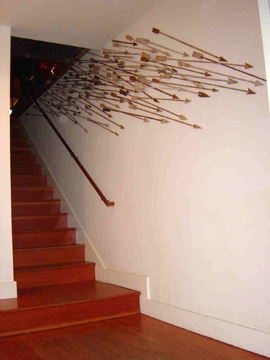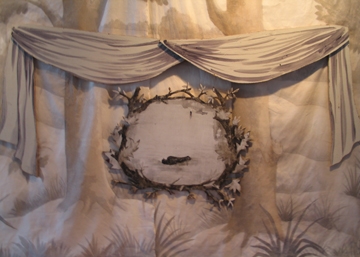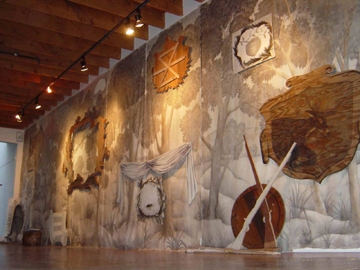Feature: Reviews
Two @ Ampersand
- Ampersand International Arts
- San Francisco
- February 13th through March 19th, 2004
Tanya Hastings, Tenuous; and Sarah Smith, The Sustained Illusion
In the stairwell entry of Ampersand International Arts, a volley of roughly hewn wooden arrows is frozen mid-stream, racing towards those entering. Flattened against the wall, they aren’t physically threatening, but I guess they symbolize such a thing. Following them to their source upstairs, one is viewing/inhabiting Sarah Smith’s installation, The Sustained Illusion, a work that’s built like a stage set or diorama backdrop. The walls are hung with painted fabric depicting an inky brown, pastoral landscape panorama. The fabric is hung loosely, with visible ripples and seams that overlap unconcernedly. In some parts of the image we can see into the distance, but trees, which spring out of the foreground and reach the ceiling, dominate the scenery. The landscape depicted might be lush and vibrant-the foliage is abundant and thick-but here it’s brown and faded like an old photograph. Hung and strewn about are various drawings on paper and objects made of wood, predominated by the same weathered, loose, sun-faded aesthetic: A lone white wing broken from its owner, a wooden ax and shield leaning in a corner, an empty frame, a drawing of two hawks at battle, an open, empty book on a tree stump, a drawing of a hornet’s nest, a fireplace with a false mantelpiece and filled with burnt arrows, a wooden crest turned round to face the wall, showing the supports on its back, and so on. The viewer senses a narrative sort of interaction, but is hard pressed to map the terrain of information.
Works like Dead Bird (2004) exemplify Smith’s talent for romance, and can help us examine the function of her work more closely. The piece is hung low to the floor and in two parts, both comprised of ink applied to cut wood. The centerpiece is a drawing of a small meadow framed by a wreath of twigs. The ground is a simple wash of ink with some deft brushwork in the upper-right corner representing the shadows of trees. In the center of the image lies the lifeless body of a bird. Turned on its back, this black disruption of the ephemeral surface of the ground is heart wrenching and elegant. Above the drawing hangs a parted wooden curtain, pulled open to reveal the picture and framing it like a theater.
The image is like an oracle, a foggy window into a mysterious prophecy. It can also serve as a window into the inner workings of Smith’s art. Her work oscillates between bodies, or orders, which convene in Dead Bird. The first order is comprised of characters, meaning images of bodies, which evoke certain feelings or tell bits of story by their condition. The characters in Smith’s work are invariably beasts. As with Bird, they’re often dead, but even when they’re not, as in the two birds of prey fighting, there’s a violence and sadness about them; they seem lost, lonely, and sometimes they seem sick. These are the inhabitants of the brown faded landscape. Because they have faces, eyes, bodies, we are sympathetic; we can see their impotence and pity it. There are exceptions, like the hornet’s nest, but it’s no far stretch to consider this hive of highly organized insects as a single organism, nor to understand it as a living character.
The second order, on the other hand, is comprised of objects. The objects represent Man as a force, they denote powers that can be imposed on the world, and they are elements that act upon the characters to generate narrative. These objects divide themselves into two parts: tools and frames. Both are made from the same roughhewn wood, further linking them as if born from the same source. The tools aren’t practical and the frames aren’t beautiful, but the way they stylize those functions is more effective than embodying them: They are placeholders for ideas. The tools are arrows, guns, and axes. They are Man as a force of violence. The frames are literally frames, and also curtains and trinkets, including objects like the open book, an ornament displaying refinement; and Cemetery Steps, a wooden drawing of steps, part of the frame of a gravesite. Frames serve to primp their contents and give more pleasure to the senses, Man as decorator. Since they are bound with the tools into the order of objects, their represented function as beauty has to be considered as working in tandem with the violence of their counterpart; and so they’re guilty as conspirators who try to cover over the dirty work of the weapons. Thus, in Dead Bird, the wooden curtain over the image of Bird implicates Man in the death.
The entire show is bound by another frame, different in nature from the symbolic ones. The landscape wall-drawing encompasses all the work and networks it inextricably. One cannot simply address individual works as hermetic objects to be visited and then left. Instead each work reads as a coordinate point on a larger diagram. In the case of Dead Bird, for instance, we are dependent on facts culled from the larger whole to inform the reading above. Each piece contributes to and sustains the larger diagram; thus the title, The Sustained Illusion, is quite apt. The illusion, however, is not of another reality, it’s of the conceptual space that all these works coordinate, the space of Smith’s imagination.
Now for something completely different: In the next room of the gallery are Tanya Hastings’s tricky pictures. Lavish in construction, they’re nevertheless deceptively simple, making it easy to think you’ve fully comprehended them on first impression. Hastings appropriates the folk practice of paper cutting from Eastern Europe and/or Southeast Asia to make skillfully handcrafted objects. It’s tempting to stop there, remark on the almost silly level of dedication required, and move on. But borrowing the paper cutting technique is only the beginning of the mix-and-match historical games Hastings nimbly plays. Her impeccable cutouts are made from ornately carved sheets of drawing paper hanging free in space a few inches off the wall.
At Ampersand, Hastings shows two large cutouts-each about the size of a king-sized mattress-made with two layers, and a small, single-layered triptych. Since they are dimensional, these wall-objects exist in a space cleared by early conceptualists (Duchamp’s Large Glass), wherein engagement is sculptural, or physical, as well as pictorial, or optical. Hastings’s imagery represents landscapes that come in two flavors: lush, vibrant forests, and soaring, stormy skies. Hearkening back to the 19th century Hudson River school landscape painting, which elaborated upon the idealist majesty of nature conceived by the Victorians, Hastings’s cutouts share that grand, powerful sense of the visual landscape, here flattened, made graphic and austere, and thoroughly modern. Hastings has taken a nonwestern technique, an Other if you will, stripped it of its political implications, and crossbred it with an American form of landscape painting entrenched with Western values. She’s also juxtaposed two visual languages and ended up with something new. Following the scent of this historical sampling, her narrow method of operating blossoms to reveal a colorful arrangement of disparate historical fragments. Laser-edged modernism meets romantic pictorialism; purist minimalism meets craft. Hastings doesn’t force these connections; her work lies effortlessly on their unlikely intersections.
Hastings freely associates these variegated sources without regard to political implication, a tribute both to the honesty of her practice and the condition of current art making. The work of Hastings and other young artists doing “new craft” calls to mind another era in which the form played a role in critical art: Feminism. The embrace of craft and outsider art was an important step in the revision of the art world that Feminism ushered in and conducted. Bringing those disenfranchised practices into the gallery-along with the newborn forms of video and performance art-was part of freeing art from the patriarchal yoke of the time. As a result of being incorporated into the feminist revolution, the practices were politically pumped up to a weight that soon became ponderous, and by the eighties outsider art was remarginalized and craft all but wiped from the cultural map once again (with notable, but minor, exceptions like the Painting & Decorating movement).
Now artists like Hastings, released from (or bereft of) the politics and critical discourse of Feminism, are mining the practices as their engines of aesthetic production. They’re customizing the methods, adding conceptual twists, updating the techniques for a more visually sophisticated, and less politically - minded, audience. In Hastings we have a satisfying result; with her work lying on an intersection between two cultural frames. It doesn’t ignore polemics, but it doesn’t invoke them either. Rather, she takes polemics in stride and weaves them into a dense complexity of concerns.
The Sustained Illusion and Tenuous are on view through March 19th at Ampersand International Arts, 1001 Tennessee St. @20th. For more information call 415-285-0170.



